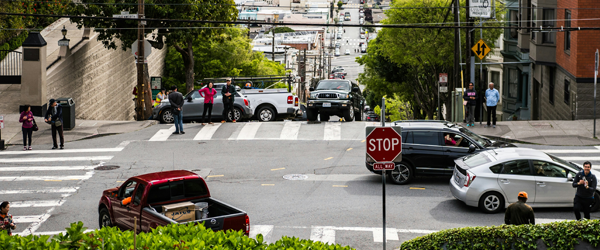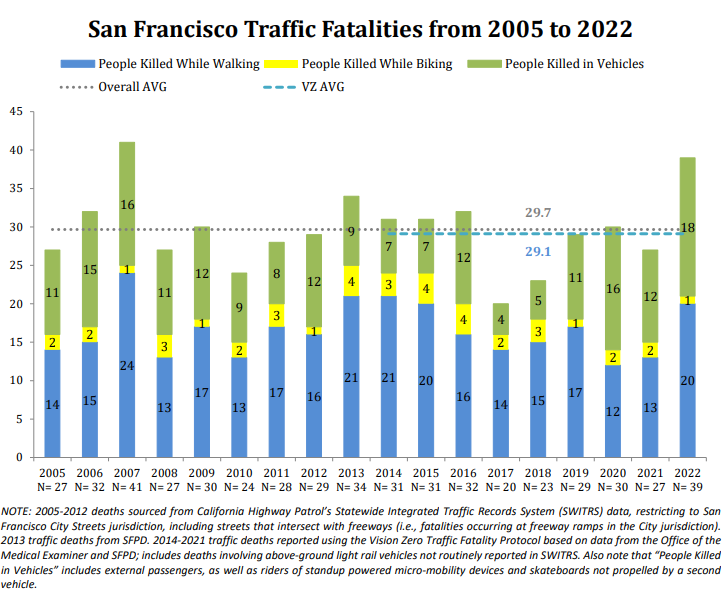
San Francisco was the second city in the United States to adopt a Vision Zero resolution back in 2014. The pledge was to reach zero severe and fatal traffic accidents within 10 years. Walk San Francisco, a non-profit we love supporting, advocated heavily to bring about Vision Zero in San Francisco. As of the writing of this post in May of 2024, San Francisco is already up to 13 fatalities this year. That is 13 fatalities over the goal and the year is not finished. The most recent fatality was just this month and the collision was in an area declared a “High Injury Network” by the Vision Zero plan. It’s time for Vision Zero 2.0 in San Francisco and we’re sponsoring Walk SF to help lead the way.
A Recap of Vision Zero in San Francisco
Since 2014, there have been 300 catastrophic collisions resulting in fatalities in San Francisco (there may still be some under investigation). 2022 was a record-breaking year that hadn’t been seen since 2007 with the most fatalities during the Vision Zero initiative. As we all know too well, nothing moves quickly in government settings, including the release of data. The most recent report from the San Francisco Department of Public Health in collaboration with the San Francisco Municipal Transportation Agency and the San Francisco Police Department was published in May of 2023 (hopefully the next report will be available soon) and recapped Vision Zero at the end of 2022. In fact, the report only counted 39 fatalities for 2022 as two fatalities were still under investigation. The report looked at demographics, modes of travel, collision factors, and even time of day to look for correlations beyond the already identified High Injury Network. Pedestrians continue to be the highest group impacted by San Francisco’s unsafe streets with the most fatalities each year.

Bringing Vision Zero 2.0 to San Francisco
As we mentioned earlier, we’re sponsoring Walk SF for Vision Zero 2.0 advocacy. It’s clear the efforts made in San Francisco over these last 10 years haven’t been enough. Other cities in the United States and around the world are making similar efforts and having much higher success rates. Why not San Francisco? Red tape, delays, leadership (or lack thereof), slow data analysis, lack of funding, lack of support, and maybe even a fear of change or backlash from drivers. You can take your pick from these and many other factors that might contribute to the lack of success so far in Vision Zero.
What we’re calling for, along with Walk San Francisco, is a renewed pledge to Vision Zero as Vision Zero 2.0. Let’s learn from the inadequacies and be brave enough to examine the failures and make the tough decisions needed for success in having zero fatalities in San Francisco streets. If we take a hard look at what we’re doing in San Francisco as compared to other cities having success with their Vision Zero resolutions, we can make Vision Zero 2.0 a success in San Francisco.
San Francisco started with Quick-Build Programs for reducing catastrophic injuries and fatalities in the High Injury Network areas, but most of the projects turned out to not be very “quick.” The delays in the projects have expanded the timeline beyond the 10-year goal. If we renew our pledge with Vision Zero 2.0 in San Francisco, we believe we can be successful. We need to move beyond the “quick” Band-Aids and address the root of what could be called a disease for San Francisco as more people have been killed in collisions so far this year than by homicide. Looking at New York, who also started Vision Zero in 2014 like San Francisco, banning right turns on red lights, reducing speeds, and adding more speed cameras to aid the Police with enforcement did show a significant drop in pedestrian deaths. We know banning right turns on red lights isn’t a small ask, but perhaps what we need to ask isn’t “can this be a quick fix,” but instead ask, “is this a necessary fix?” When lives continue to be lost, we want to look at necessary interventions, even ones that may not be so popular with drivers like ending right turns on red lights. San Francisco needs to be safe and end collision-related fatalities more than it needs to get you to work on time when you got out the door late.
How You Can Help Make Vision Zero 2.0 a Reality
Start with a visit to Walk San Francisco’s Vision Zero Campaign page. On the right, you’ll see a menu of resolutions by district. You’ll be able to quickly and easily send a letter to your district’s Supervisor thanking them for supporting Vision Zero and asking them to renew their efforts. Let them know why safe streets matter to you.
Next, we need a plan of action from City and Government Leaders. S.B. 961 just passed at the State Senate and is going to the Assembly. Bills like this that target the root of the problem, like speeding drivers in this case, are going to be necessary as part of a plan of action. Do your part and VOTE for action items like S.B. 961 when they become available for a vote. And when they start working their way through the government, send letters of support to your leaders and ask for their support in making positive changes that will save lives. If you don’t know what’s coming up in government that might save lives for people in San Francisco, check out the news page from Walk SF. They will frequently post not only what’s coming but whom to contact with your support or request for change. They also frequently have something posted on their Take Action page.
What is S.B. 961?
SB 961 would require all cars and trucks manufactured or sold in California starting in 2027 (except emergency vehicles) to have ‘Intelligent Speed Assistance’ technology. All new vehicles in Europe will have this starting this summer. SB 961 would require audio and visual warnings to the driver when the vehicle is being operated in excess of 10 MPH over the speed limit.
If passed, SB 961 would bring needed safety technology into the vehicle fleet in California and likely our entire country, just like when seat belt laws started at the state level.
